Converge: Disciplinarities and Digital Scholarship encourages design educators, design researchers, and designers to take advantage of opportunities in digital scholarship, learn how to collaborate on interdisciplinary projects, and find new intersections within their existing research trajectories. To redefine what it means to be a designer and a design researcher today, we ask: How can design converge with digital scholarship in more than a superficial way? How might aspects of digital scholarship impact design research? What are the key questions at the intersection of design and the humanities?
This conference took place June 1-3, 2017 in Los Angeles, CA.
Keynote Speakers
Johanna Drucker
Breslauer Professor of Bibliographical Studies, Department of Information Studies, UCLA
Casey Reas
Professor, UCLA Design Media Arts, and Co-Founder, Processing
Erik Loyer
Creative Director, The Alliance for Networking Visual Culture
Conference Location
School of Cinematic Arts (SCA)
University of Southern California
900 West 34th Street
Los Angeles, CA 90089-2211
Connect
converge.aiga.org
converge.aiga@gmail.com
facebook.com/groups/AIGAConverge
twitter.com/aiga_converge
#aigaconverge
Organizing Committee
Jessica Barness
Associate Professor, School of Visual Communication Design, Kent State University
Her research resides at the intersection of design, humanistic inquiry, and interactive systems, investigated through a critical, practice-based approach. She has presented and exhibited her work internationally, and has published research in Design and Culture, Dialectic, Visual Communication, and Message, among others. She recently co-edited a special issue of the journal Visible Language with Amy Papaelias entitled “Critical Making: Design and the Digital Humanities” (2015).
Vicki Callahan
Associate Professor, School of Cinematic Arts, at the University of Southern California.
Her research and teaching is focused on the integration of theory and practice with attention to issues in film and media history, feminist studies, digital culture, media strategies for social change, and public scholarship. She was an NEH fellow for the inaugural workshop, “Scholarship in Sound and Image,” on Videographic Criticism at Middlebury College, and in 2015 she was in residence at University College Cork, Ireland as a Fulbright Scholar with a focus on digital media praxis.
Heather Corcoran
Director, College and Graduate School of Art; Professor, Design, Washington University in St. Louis
Her work explores relationships between information and expression in collaborative projects for social impact and self-generated projects for exhibition. She was lead author on the article “Making cancer surveillance data more accessible for the public through Dataspark,” published in Visible Language in 2013, and co-principal investigator on a grant funded by the National Cancer Institute (NIH), 2009-11. An exhibition of her work, Reading Time: Visual Timelines, Texts, and Canons, opened at Gallery 360 at Northeastern University in Boston in 2014.
Sarah Lowe
Professor, Graphic Design, University of Tennessee
Her work across technology, cultural heritage and museum studies researching the design of digital engagement with the public has led to research partnerships with The National Park Service, The US Holocaust Museum, and the Eastern Band of the Cherokee Nation. Her work has been presented at CUMULUS, NORDES and the Museum Computer Network (MCN) in addition to several DEC conferences. In 2012/13 she was a Fulbright Scholar at the University of Oslo, Norway, researching the design of educational technologies in relation to learning theory.
Amy Papaelias
Assistant Professor, Graphic Design, SUNY New Paltz
She has presented her design research and pedagogy at Theorizing the Web, the Type Directors Club, NYC DH Week, TypeCon, and other DEC conferences. In 2013, Amy participated in One Week One Tool, an NEH-funded Institute for Advanced Topics in the Digital Humanities. She co-edited a special issue of the journal Visible Language with Jessica Barness entitled “Critical Making: Design and the Digital Humanities” (2015). She is a founding member of Alphabettes.org.
Holly Willis
Chair, Media Arts + Practice, School of Cinematic Arts, University of Southern California
Former DEC Steering Committee co-chair, Holly works at the intersection of cinema, design, media literacy and the humanities. She co-founded and launched the practice-based Media Arts + Practice program integrating design research and critical theory/making, and is currently involved with USC’s Mellon-funded Digital Humanities Program supporting humanists in manifesting their research through media-rich experiences. She has helped organize and has presented at many previous DEC conferences, including New Contexts/New Practices, Schools of Thought III and NEXT
SPONSORS
USC School of Cinematic Arts
Washington University in St. Louis
Kent State University: College of Communication and Information, School of Information, School of Visual Communication and Design
Browse the Converge: Disciplinarities and Digital Scholarship Collections
Ice-Time: Art-Science Expedition Field Report
06/03/2017Clea T. Waite, University of Southern California
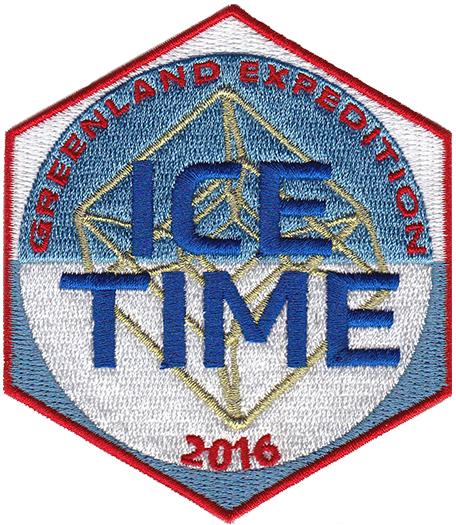
The Ice-Time project is a creative response to the perilous state of Earth’s ecosystem. Ice-Time will be an immersive, multi-projection video and sound installation combining art and science that minutely examines the structure of ice to reveal the time embedded within. The project conveys the essence of ice and its intimations, eliciting the poetics contained within frozen water as revealed by current climate research. Glaciers, like geology, are a primary indicator of the deep time of our planet’s environment. Ice is also the most visible indicator of the short-term effects of climate change. Glacial ice presents a four-dimensional hyper-view into time and space, an icy tesseract giving us an 800,000 years view backwards into Earth’s climatological past and forwards towards the pending outcomes of current rising temperatures.
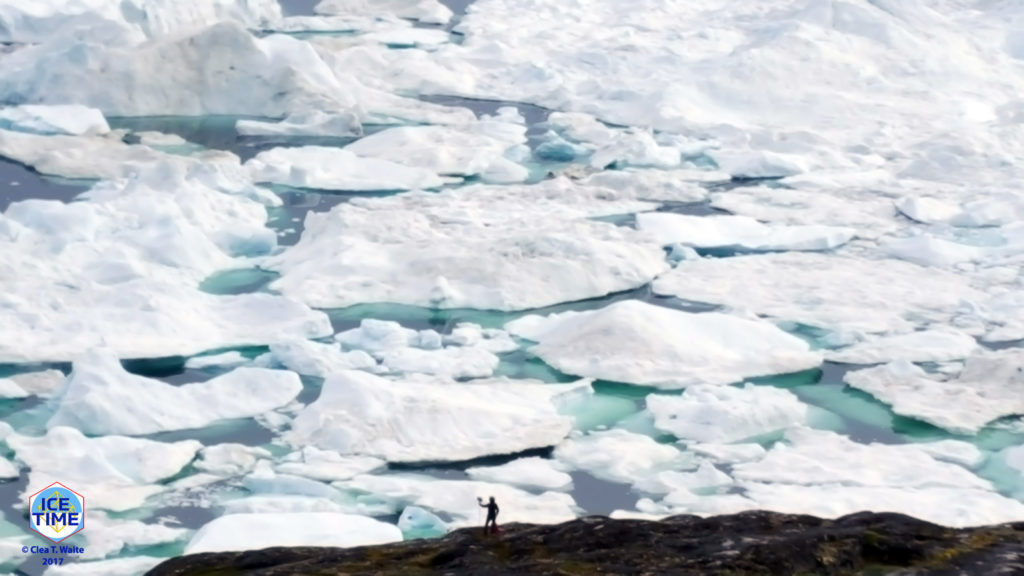
Angelika von Chamier recording sound at the Ice Fjord Ilulissat, Greenland. 6.2016 This essay presents the cinema-installation Ice-Time as work-in-progress, focusing on the project’s background research. We present a field report from our filming expedition to Western Greenland in 2016, above the Arctic Circle, in which we combined the methods of a naturalist in the field, collaboration with experts, and the collecting of scientific and cultural data.
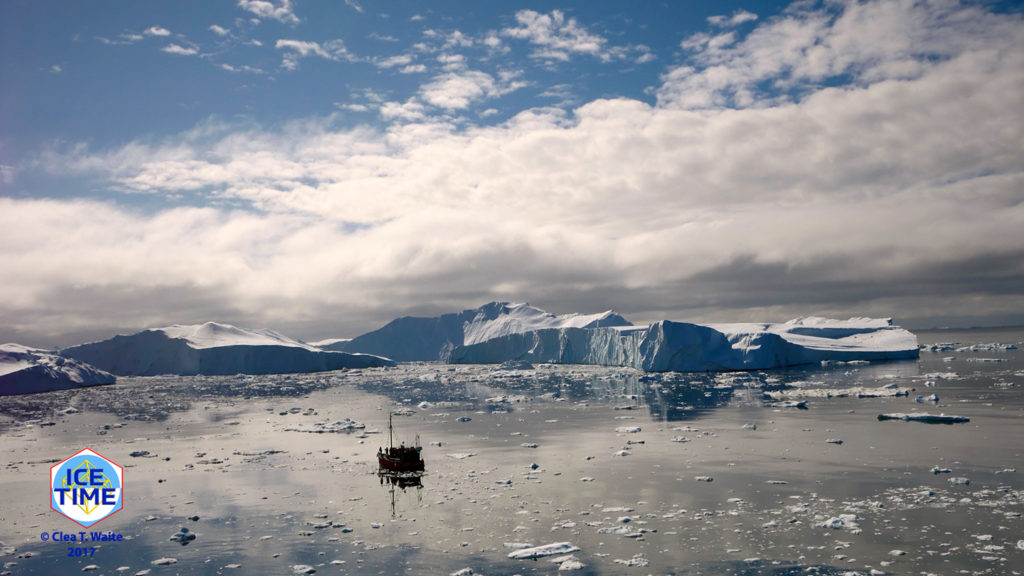
Ice-Time still frame 
Clea T. Waite filming Ice-Time on the Ice Fjord Ilulissat, Greenland. 6.2016 Ice-Time focuses on the relationship between ice, time, climate, and Western culture. The film occupies a hexagonal, six-screen cinema architecture of translucent projections that layer in a faceting effect, merging into crystalline collages of shifting combinations as visitors move through. A three-dimensional soundscape expands the image space, composed from the field recordings of live ice, sonified glacial data, excerpts of interviews with researchers, and literature. By means of a vivid, material presence of image, sound, data, and time, the immersive cinema-installation presents a proprioceptive interaction of form and content, creating an embodied, participatory film that imbues the spectator with a deep awareness of the environmental and cultural implications of ice.
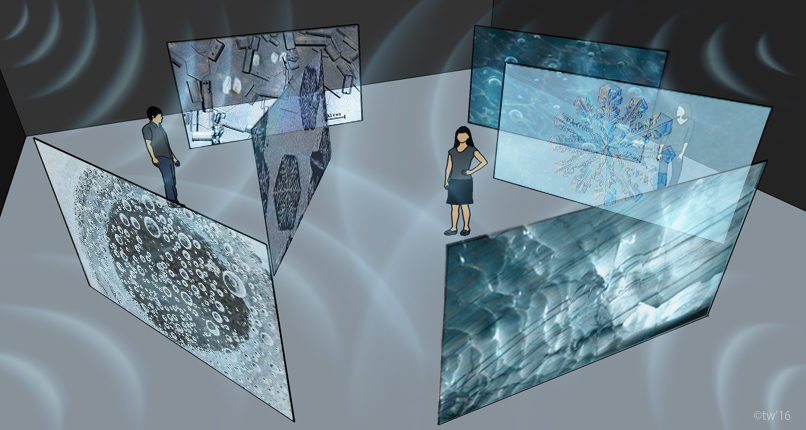
Model of the Ice-Time installation Clea T. Waite is an intermedia artist, scholar, and experimental filmmaker whose artworks investigate the artifacts and poetics that emerge at the intersection of art and science. She creates somatic, cinematic works that engage with climate change, astronomy, particle physics, and popular culture via immersion and sensual interfaces – as well as one inter-species collaboration with several hundred tropical spiders. Currently completing her PhD at the University of Southern California in Media Arts + Practice, Waite combines a background in physics and computer graphics from the MIT Media Lab with her current research in cinema, media art, and critical theory. This multifaceted background brings a unique blend of expertise to her projects from which cross-disciplinary synergies emerge. Waite’s artworks have been exhibited and awarded internationally, notably the IBM Innovation Prize for Artistic Creation in Art and Technology, the GC3 at the Miraikan National Museum of Emerging Science and Innovation, and most recently the Open Sky Project for the ICC tower, Hong Kong. Recent publications include articles in the Spherical Book Project from the Aalto University Tangential Points Publication Series, Inspiration of Astronomical Phenomena published by the Astronomical Society of the Pacific, Animation Practice, Production & Process from Intellect Journals, and proceedings from the International Symposium on Electronic Art. Waite’s fellowships include an Alexander von Humboldt Foundation Fellow, a Radcliffe Institute for Advanced Studies Fellow, CERN European Laboratory for Particle Physics artist in residence, and fellow at the Academy of Media Arts Cologne. Waite has previously held positions at the Academy of Film and Television Babelsberg, Pratt Institute, New York, and the University of the Arts, Berlin.
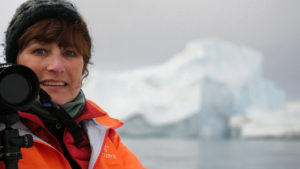
Clea T. Waite on expedition in Greenland for “Ice-Time” This was a Lightning Round Session on June 3, 2017. 10:30–11:00am (SCI 108)
How to Teach Design to Non-Design Students and Create Programs for Non-Designers
06/01/2017Joyce Walsh, Boston University
Students and professionals in the STEM and humanities fields recognize a need for visual strategies to improve their communications and products. Consequently, many non-designers want to learn design software and would benefit from knowledge of design fundamentals. This workshop will present a proven method for teaching relevant design skills along with creative software skills. This is an efficient teaching method intended for novice designers or non-designers.
The workshop will share an integrated approach: how to teach design principles and strategies simultaneously with industry-standard creative software (Illustrator, Photoshop and InDesign). For example, as students learn to use color to create effective visual hierarchy, they learn Illustrator skills.
Features of this method include:
- All software skill instruction reinforces design principles
- Design knowledge and software skills are built incrementally
- Teaches design strategies that are relevant to non-design profession
This strategy can also be used to expand design programs to a broader audience. Students may come from any discipline and be graduate students, undergraduates or professionals. Equipped with color, type and information organization strategies, these students can make more effective digital products such as apps, websites and presentations.
To support this approach, I wrote the first book combining design with software skills. It was published internationally by Laurence King and Pearson, and has a Chinese edition. It is now available in a pdf version on my website.
Joyce Walsh is an Associate Professor at Boston University.
This was a workshop on June 1, 2017. 3:30–5:30pm (SCI L106)
Here I Am: A Collaborative Exhibition Between Technology And Art History Students Exploring Culture And Identity
06/03/2017Caroline McCaw, SUNY Canton (Fulbright Scholar-in-Residence, 2016–17)
Kathleen Mahoney, SUNY CantonAnei Au (Here I am) was a collaborative student project – an interactive exhibition produced between two courses in Graphic and Multimedia Design at SUNY Canton in 2016. This paper discusses the intercultural collaborative processes and digital tools employed through the concept and development stages of this exhibition, the project’s challenges and its unique outcomes. It reflects on how the project helped us to consider our own identity, our place in the world, and to compare the fleeting nature of digital and social media within a deeper investigation into media ecologies as they offer an approach to reconsidering our place in a complex contemporary system.
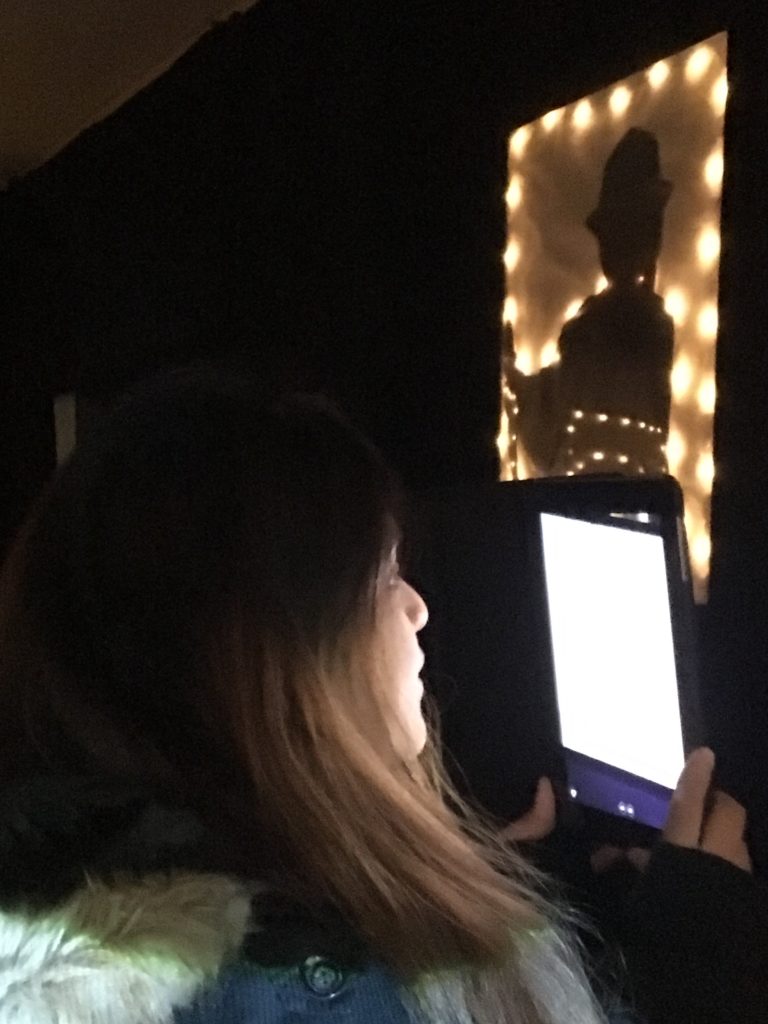
Caroline McCaw usually lives in Dunedin, New Zealand. She was a Fulbright Scholar-in-Residence at SUNY Canton in Northern New York for the 2016-17 academic year. Caroline’s research considers the role of art and design research in reconceiving landscapes as social. She loves project-based learning. caroline.mccaw@op.ac.nz
Kathleen Mahoney is an Assistant Professor at SUNY Canton’s Graphic and Multimedia Department. She has 20 years experience as a graphic designer and artist working in New York City. Kathleen teaches graphic design and programming interactive media for artists and designers. mahoneyk@canton.edu
A huge thanks to New Zealand artist Vicki Lenihan and her role in the project: for reminding us of the importance of Ancestors across cultures, for her involvement with the students in developing their exhibition concept, and for editing this initial paper.
This was a Long Paper Session: On Collaboration on June 3, 2017. 11:30am–1:00pm (SCI 106)
Greenhouse Studios / Scholarly Communications Design at the University of Connecticut
06/03/2017Samantha Olschan, Greenhouse Studios, and University of Connecticut
Background
The University of Connecticut’s Digital Media & Design Department (DMD), in collaboration with the University Libraries and University of Connecticut Humanities Institute (UCHI), have launched the Greenhouse Studios / Scholarly Communications Design at the University of Connecticut (http://greenhousestudios.uconn.edu/). With funding from the Andrew W. Mellon Foundation, and backed by long-term University investments of staff and space, Greenhouse Studios will implement a design-based, inquiry-driven, collaboration-first workflow that will address the divided workflows and counter-productive labor arrangements that have complicated scholarly communications in the digital age.
Even as the scholarly communications field pursues the opportunities presented by digital technology, its routine operations remain anchored in print-centric regimens. For those working to evolve scholarly communications in the Internet age, particularly as it bears upon long-form scholarship, there is compelling need to productively disrupt and reconfigure the workflows and work cultures that have naturalized around the production of printed products. Taking inspiration from Design Thinking (and its critics) – artists, designers and developers are brought in at the early stages of scholarly research to provide artistic design, creative expression, and technical implementation assistance for project iterations and development.
Objective
The paper will address how designers are finding roles, and perhaps more importantly, asserting the value of design in collaborative research and interdisciplinary projects related to digital scholarship via Greenhouse Studios at the University of Connecticut.
By observing the established working process model, current projects and pipelines, and the branding process of the Greenhouse Studios we seek to answer the questions: How can we better articulate the scholarly merit of collaboration? How can collaborative design scholarship and projects be positioned within the tenure and promotion process in the field of design to positive outcome? What are the forms these scholarly activities might take? How might these scholarly practices affect design education?
Methods
The paper will outline the development of the cross-disciplinary process model, projects, and the branding process for Greenhouse Studios / Scholarly Communications Design at the University of Connecticut. Through this development and implementation the studio illustrates how incorporating the designer, implementing design thinking, and adopting an evolutionary approach to identity and information design at the early stages of scholarly projects, impacts the value of design in research and interdisciplinary collaboration.
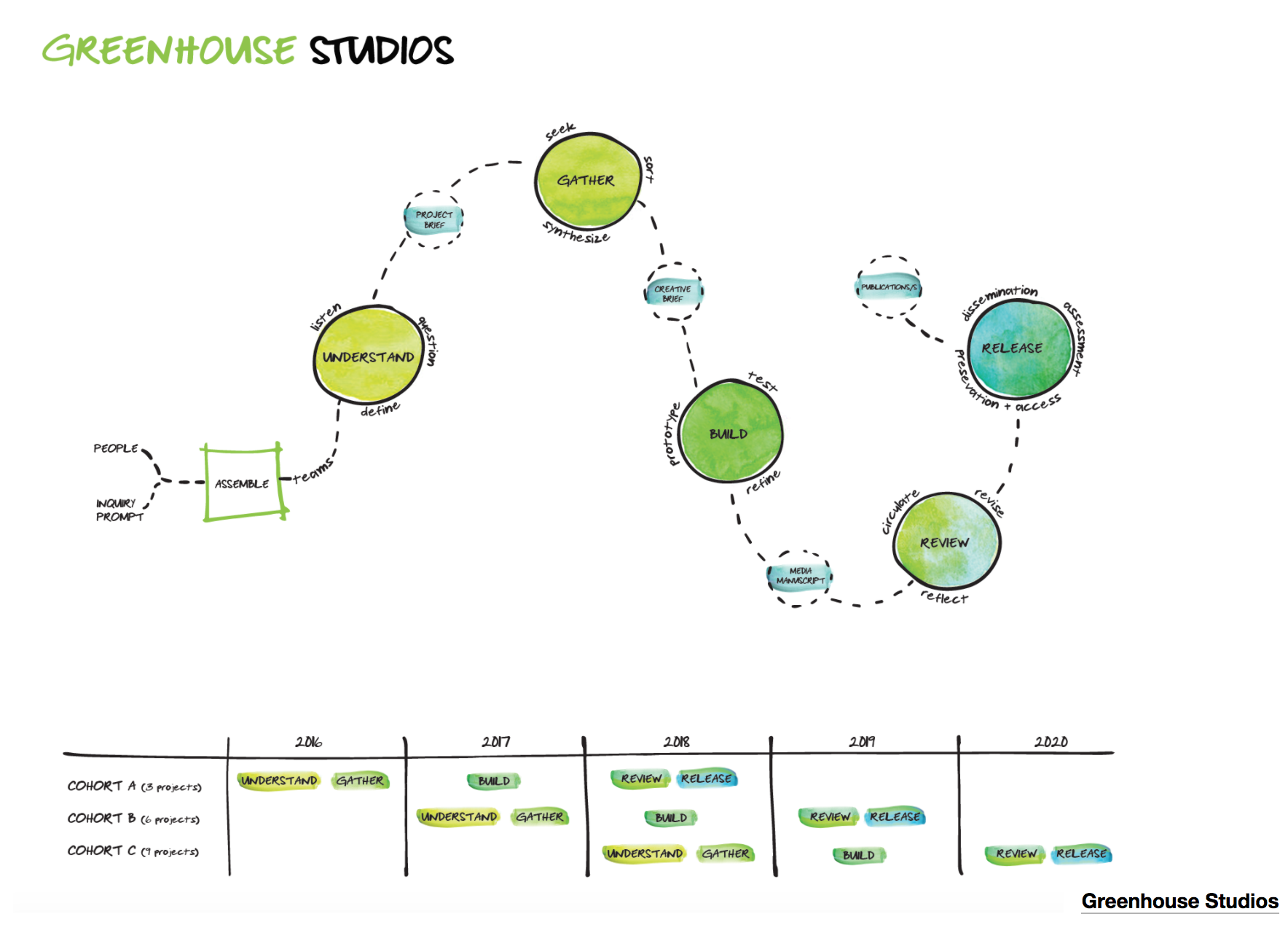
In defining and documenting our evolving process/practice, we began to observe how early integration of the designer in scholarly practices and communication affect and illuminate project outcomes, our reflections on the building and design process, as well as opportunities for design education.
Throughout the development we documented our process and practice in a variety of ways, through still photographic imagery, moving image and time-based media, iterative visual communication and graphic design, animation and motion graphics. This practice allowed for the team to derive creative content for further communication, marketing, illustration and production but also reflect on their practice and process.
We identified the best visual communication style for the project, process charts and generated an open-source, hand-rendered typeface with students and interns, based on handwriting, (the “artists hand”) to pay homage to traditional practices, research and publishing methodologies while referencing emerging technology and media through digitization.
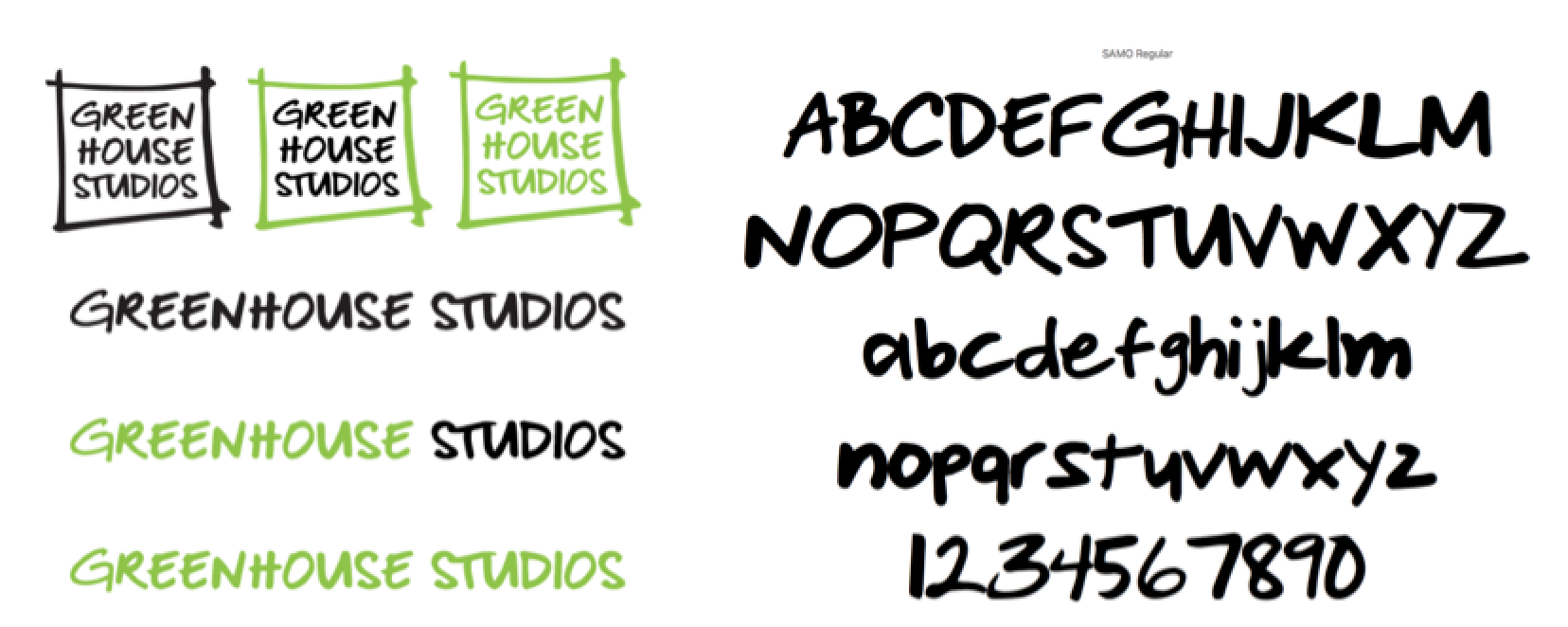
http://greenhousestudios.uconn.edu/ Samantha Olschan is a transmedia artist & designer with a M.F.A. in Film, Video & New Media: Animation from The School of the Art Institute of Chicago & a B.F.A in Fine Arts: Electronic & Time-Based Media from Carnegie Mellon University. Having worked across broadcast design, animation, compositing and time-based visualization for television, films, documentaries and media agencies, she continues to research hybrid media & storytelling through animation, design & experiential narrative.
Recent exhibitions and screenings include the Black Maria Film & Video Festival, FrackFest, P.O.V. Series (PBS), The ShortList (PBS), Visionfest, Tribeca Cinemas, Bumbershoot, Seattle International Film Festival, Boston Cinema Census, Boston Underground Film Festival, Conversations at the Edge, The Gene Siskel Film Center, Marblehead Film Festival & the Skopelos Foundation for the Arts in Greece. Teaching appointments in animation, media and design include University of Connecticut, Pratt Institute, Wesleyan University, Quinnipiac University, Columbia College, New York Film Academy & The School of the Art Institute of Chicago.
She is currently an Assistant Professor in the Digital Media & Design Department (dmd.uconn.edu) at the University of Connecticut.
This was a Long Paper Session: Student-led Labs on June 3, 2017. 9:00–10:30am (SCI 106)
From Design Thinking to Divergent Thinking: How Visual Communication Design works across areas of Knowledge and Brings them Together
06/03/2017Yvette Shen, The Ohio State University
Xun Michael Chi, Laguna College of Art + Design
Yoshiko Burke, University of Cincinnati
Chen Wang, California State University, FullertonIn design institutions across the United States, we are experiencing a paradigm shift in visual communication design education. Technological changes have radically altered the ways in which visual communication is defined and its role in our culture. Besides technological changes, design content and context have also fostered new directions of thinking about space, typography, colors, symbols and icons, balance and unity. These shifts bring unprecedented complexity. With the widespread use of integrated digital media and more collaborative approach to problem solving, the visual thinking and creative process are also taking place in a much wider context.
This panel exams pedagogical methods and creative processes that connect visual communication design and the following areas of study: information visualization, photography, documentary filmmaking, and user-experience design. A modern visual communication design class often deals with orchestrating different media components within an integrated and sometimes interactive whole. Multi-discipline collaboration is often necessary for problem solving. Thus, the design faculty faces the challenge of setting up a more “dialogical” educational environment rather than an “instrumental” one, yet still capitalizing on the depth and breadth of visual communication design – how it functions as an infrastructure that can bring areas of knowledge together and open to new set of connections, meanings and narratives.
Starting from the initial curriculum plan to project execution and evaluation, this panel intends to look into methods of integrating the analytical approach to the creative visual culture. Through practical examples, we will demonstrate how visual ideas can be generated, tested and altered in a variety of ways to create final visual solutions. We also aim to promote a cross-disciplinary learning environment that allows students from different educational background to quickly conceive, present, and communicate through visual representations in order to make valid design decisions and explore meaningful associations. Last but not least, this panel believes today’s design education should focus on not only the traditional design concepts, but also the importance of broadening students’ thinking and stretch their perceptions. The possibility of infinite connections between visual communication design and other disciplines is calling for the need for divergence – divergent thinking – which is required to stop the “techno-homogenization” of the creative process.
Visualizing as Thinking: The Non-Designers’ Design Education in Information Visualization
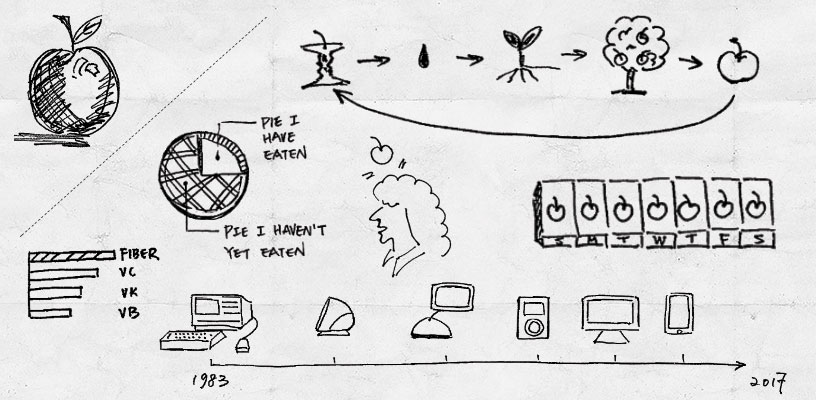
The most effective method of teaching critical thinking is to allow students to envision what their thinking looks like. This presentation focuses on a design course for non-design majored students about using visual frameworks to communicate ideas, concepts, and meanings. Regardless the nature of the problems, students learn to identify and apply visualization skills to improve their abilities to look at problems, see patterns, imagine solutions, and show the solution to others effectively and efficiently.
Design Thinking in Photography
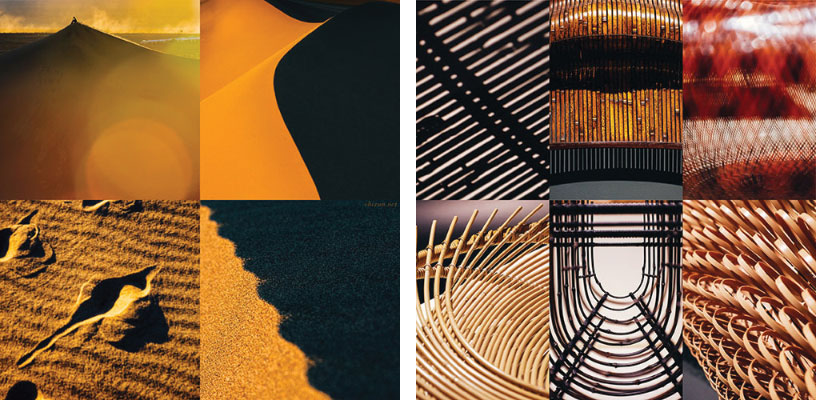
This presentation discusses how graphic design elements, principles and rhetorical figures can enrich the language of photography. A series of innovative interdisciplinary class projects between graphic design and photography will be presented with the curriculum planning. Students are challenged to investigate the endless possibilities of applying design thinking into photography, both conceptually and visually, and using photography to infuse creativity into visual communication designs.
Digital Convergence in an Interdisciplinary Setting: The Production Master Class
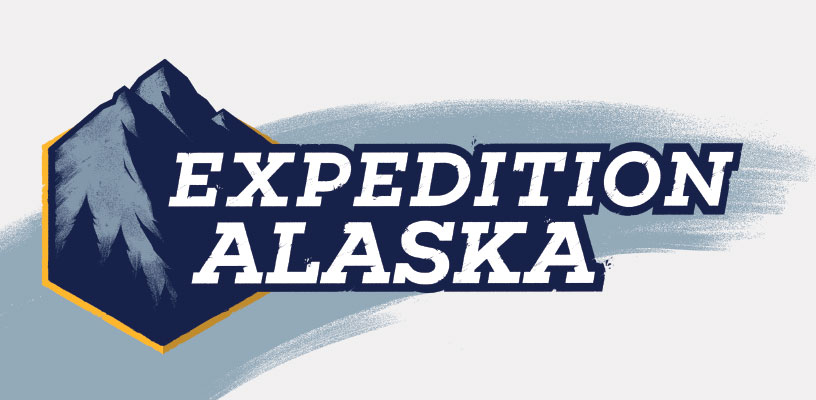
For the past four years, the Production Master Class at the University of Cincinnati has used interdisciplinary collaboration to transform the experiences of students in the remote settings of California’s Sierra Nevada Mountains and Alaska’s Kenai Peninsula into converged digital media projects that have been distributed to audiences worldwide. To facilitate this collaboration, the PMC uses an online “digital classroom” developed and taught by two professors from different disciplines and a professional filmmaker and television director/producer. This initiative has allowed students from nine different academic programs at three UC colleges to fuse their work into award-winning outcomes for students and faculty. Integrating this pedagogical methodology into digital education curricula exponentially expands what can be taught, how it can be conveyed, and where learning can take place.
EXPAK video teaser- https://video.kent.edu/media/EXPAK+teaser/1_podvgh7e
How User-Centered Research Redefines Design Process
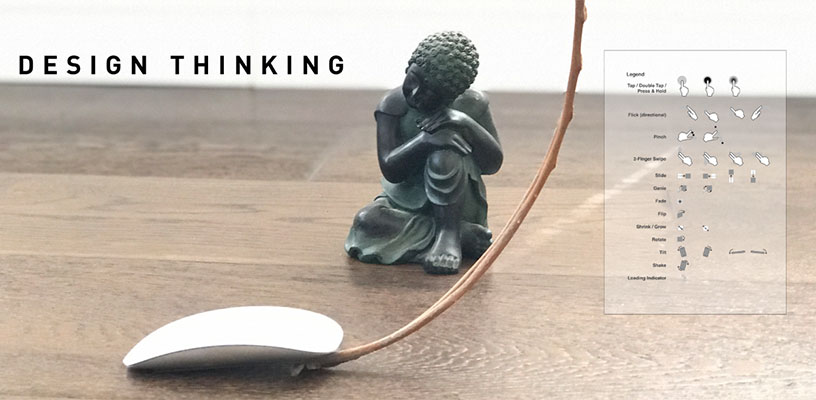
For interactive media development, it proceeds with the user as the center of the focus. User Experience Research such as user analysis, personas, scenarios and user flow will alter the way how graphic designers used to work. The behavior of interaction affects product definition, which is about what functionality a product has as opposed to defining how that functionality is manifest, which is the traditional role of design. This presentation will use class projects as case studies to demonstrate how students benefit from those emerging development methodologies and how an evolving design process influences the planning, designing, and developing an interactive product.
Yvette Shen is a visual communication designer and educator. She currently works as an Assistant Professor of Visual Communication Design at The Department of Design, The Ohio State University. She formerly practiced web, interactive, and print design for clients such as Lenox Hill, HGTV, ESPN, Saucony, Abbott, Novartis, Comcast, and various galleries and art events in New York City and Boston. Currently her research and creative work are mainly focused on information design, data visualization, and statistical graphics. Her creative works have been recognized and awarded by various design organizations and publications such as Information is Beautiful, Photomediations Machines, Civic Media Project, GD USA, AEJMC, BEA, Adobe Design Achievement Awards, Creative Quarterly, Applied Arts, etc. Her work has also been exhibited worldwide. Website: yvetteshen.com
Xun Michael Chi is an associate professor of visual communication at Laguna College of Art + Design. Chi holds an MFA from Purdue University, where his works achieved nationwide academic recognition. He also has a medical degree from Tianjin Medical University in China. He teaches various of courses including Graphic Design – Conceptual Thinking, Composition and Color, 3D animation and Photography. His photography has been featured in various magazines worldwide including Juxtapoz, Elle UK, Vogue Australia, Harper’s Bazaar China, Esquire China, etc. In 2016, he held a solo photography exhibition in Contemporary Art Museum of Ningbo, China. Chi has been invited as guest speaker in some top universities including Beijing University, China Central Academy of Fine Arts, Beijing Normal University, etc. Chi is an executive member of The Association of Chinese Artists in American Academia. As a curator, Chi curated several international photography exhibitions. In 2016 Chi won the Excellent Curator Award in Pingyao International Photography Exhibition, China. Website: www.chixun.net
Yoshiko Burke is an Associate Professor of Communication Design in the Myron E. Ullman, Jr. School of Design at the University of Cincinnati’s College of Design, Architecture, Art, and Planning.
Burke’s breadth of professional experience as a visual communication designer and a digital media producer ranges from concept development to content production. Her current area of expertise lies in visual storytelling, motion graphics, and information narrative. Burke’s creative projects have been involving directing and creating visual narrative content for on-screen media. She has produced interactive narrative and documentary projects that garnered national awards from multiple Telly Awards, the Broadcast Education Association Media Arts Festival’s Interactive Multimedia Best of Competition Award, and the King Foundation Award. Her interactive documentary, The New Issei was supported by a 2006 Ohio Arts Council grant and premiered at Cincinnati Art Museum. Prior to her tenure with the UC, Burke worked professionally in the area of digital design, where she produced web/multimedia content for a number of Fortune 500 clients. Her mixed media artwork has also been exhibited both nationally and internationally.Chen Wang obtained a Master of Fine Arts degree from University of Iowa in 2003. He has taught at Texas Tech University as an Assistant Professor in Communication Design. Currently he is a Professor teaching Graphic & Interactive Design at California State University, Fullerton. Chen’s research interests lie in the fields of visual communication across both print and digital media. In the past few years, Chen’s work have been accepted, exhibited and awarded by numerous international design competitions including the 19th New American Talent Competition, The 9th International Biennial of the Poster in Mexico, and GOOD50x70 poster Design competition in Italy. Chen’s design work has been featured in book “LOGO SAVVY: Top Brand-Design Firms Share Their Naming and Identity”, “Color Management for Packaging”, and “Color Management for Logos” that’s distributed internationally.
This was a Panel Session on June 3, 2017. 2:30–4:00pm (SCI 106)

